Personal Information
- (Professor)
Gender:
MaleDiscipline:
Acoustics. Optics. Condensed Matter PhysicsEducation Level:
With Certificate of Graduation for Doctorate StudyDiscipline:
1 Acoustics;
1 Optics;
1 Condensed Matter Physics
Other Contact Information
-
ZipCode
7babf8b996fc02ba8f391f8b71b22a8bcd3f4abeccc50782ac500df2fc7bbbfd33ec0121535ccb720ea6e8c8df3da800745dcf948c0bd9a02ad5c77e04e6d33c04185bb88739ad1e39fd79615c8afd8e3118d468533fff05fefb4c3e65073aa021f4b7573ae694db00bd0033171d46e65f649f546418a26ce92eabcfbdf7fea1 -
PostalAddress
14da4b058cc6c8fd9f13c292347ca8926a9d7a11783f5f48e0e675dcb4a46ffbbf8038bd204689e46ed015cea133adf35509ba76687d7097671d38a9bc6460eaf0bf5f97600be544abd4f6ad8a690711eaa16a5ee79aa2055b67989adfbe6504a5046edb34dcfdf53713a19edb57267993e0bd67a214d6f2f4f2e1cde417a1b3 -
email
07a6a8f1600fc9f509bb97322af381894a7656bb803f70f1eee67af3f98a92ec2aede598b4d92c576f414b94557f2a6c36315a9e3d6bc4c44d7ebc64bda2a6d40d83981c2d70810d16711ce1454bdbaae8a3b0b4780ccfc2a2bc7ebfc38410c10c301058ca0d4af6c737b901fb83dca4aa9aa509da4e4afe72ca660b8019bae4




New20
Nonlinear Chiral-like State Transfer realized with a minimal set of parameters
The research team led by Professor Meng Xiao at Wuhan University has pioneered a new mechanism for Nonlinear Chiral-like State Transfer, successfully realizing such state transfer with a minimal set of parameters. Their findings have been published in Nature Communications under the title “Nonlinear Chiral-like State Transfer realized with a minimal set of parameters.” The corresponding author of the paper is Professor Meng Xiao from Wuhan University, and the first author is Dr. Kai Bai, a postdoctoral researcher at Wuhan University. In addition, graduate students Chen Lin, Tao Liu, Jiazhen Li, and Xin Lü from Wuhan University made outstanding contributions to this work.
Chiral state transfer refers to the phenomenon where, during adiabatic evolution along a closed trajectory in parameter space, the final state of a system depends solely on the direction in which the loop is traversed. This phenomenon holds potential for a range of applications, including energy transfer, photonic chips, unidirectional lasing, quantum control, and mode switching. However, conventional realizations of chiral state transfer rely on adiabatic evolution of non-Hermitian Hamiltonians in parameter space, which demands high experimental complexity and long evolution times, severely limiting their practical use in integrated devices.
To address these challenges, the authors propose and experimentally demonstrate, for the first time, a novel mechanism for chiral-like state transfer based on nonlinear exceptional points, where the state evolution is governed by the structure of steady-state basins of attraction. Under this mechanism, the nonlinear system achieves chiral-like transfer between steady states by switching among only three discrete points in parameter space—without any need for adiabatic evolution—thus significantly reducing the experimental difficulty.
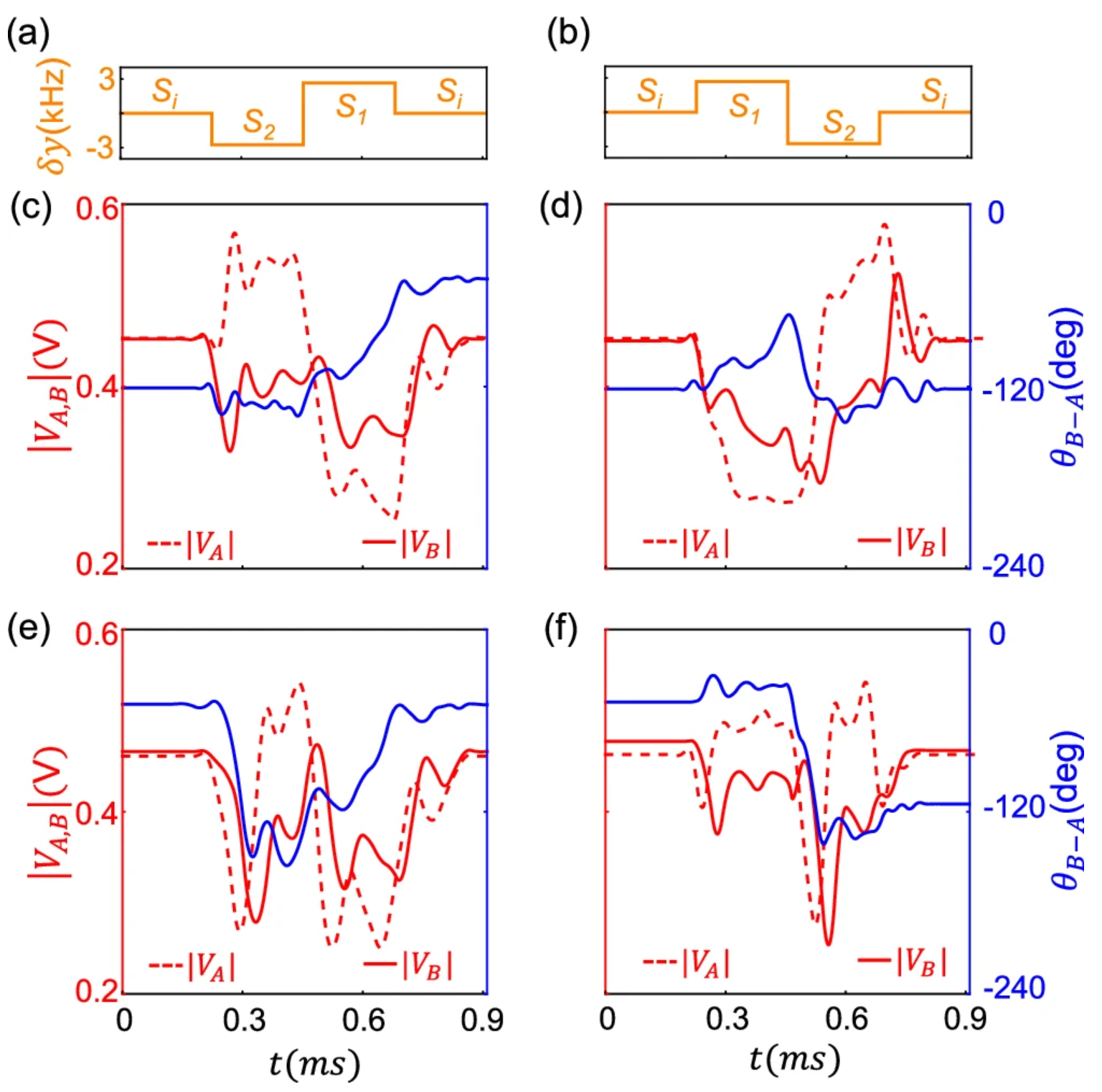
Figure 1 | Experimental observation of nonlinear chiral-like state transfer. (a, b) Parameter evolution trajectories. (c–f) Evolution trajectories of the system’s wavevector. The final state of the system depends on the direction of the parameter path.
Link: https://www.nature.com/articles/s41467-025-61372-2
New19
Janus Bound States in the Continuum with Asymmetric Topological Charges
Researchers from the Hong Kong University of Science and Technology and Wuhan University have unveiled a new class of photonic states that offer unprecedented control over light confinement and polarization. Dubbed Janus Bound States in the Continuum (BICs) after the two-faced Roman deity, these novel states exhibit asymmetric topological charges—distinct “vortex” characteristics for light radiating upward versus downward—while retaining an infinite quality (Q) factor.
BICs are counterintuitive resonances that, despite lying within the spectrum of free-space radiation, do not leak energy. They act like perfect light traps, enabling sharp optical resonances, enhanced lasing, and ultrasensitive sensors. Traditional BICs, however, carry identical topological charges on both sides of a slab, limiting how one can manipulate the directionality or chirality of emitted light.
Researchers break this symmetry by engineering a bilayer photonic crystal slab whose upper and lower layers differ slightly in hole geometry. This out‐of‐plane mirror symmetry breaking splits accidental off‐Γ point BICs into pairs of circularly polarized states, then selectively merges four of these states back at the Γ point—but only for one side. The result: a Janus BIC with topological charge +1 upward and –1 downward, all while preserving the infinite Q factor that makes BICs so powerful.
Taking the symmetry-breaking further, by rotating the elliptical holes, the team achieves Janus chiral BICs. Here, only one handedness of circular polarization converges at the Γ point in each direction, imbuing the state with large intrinsic chirality (near-perfect circular dichroism) alongside its infinite Q. Such states could enhance chiral emission, sensing, and enantiomer separation.
By controlling Pancharatnam–Berry phase singularities in momentum space, Janus BICs offer a compact route to generate vortex beams, key for advanced optical communications and quantum information processing. Moreover, their asymmetric polarization vortices pave the way for nonreciprocal photonic devices that could route or isolate signals.
By unlocking asymmetric light behavior, Janus BICs represent a major advance in topological photonics—and open new paths for photonic devices that exploit direction- and spin-dependent light–matter interactions.
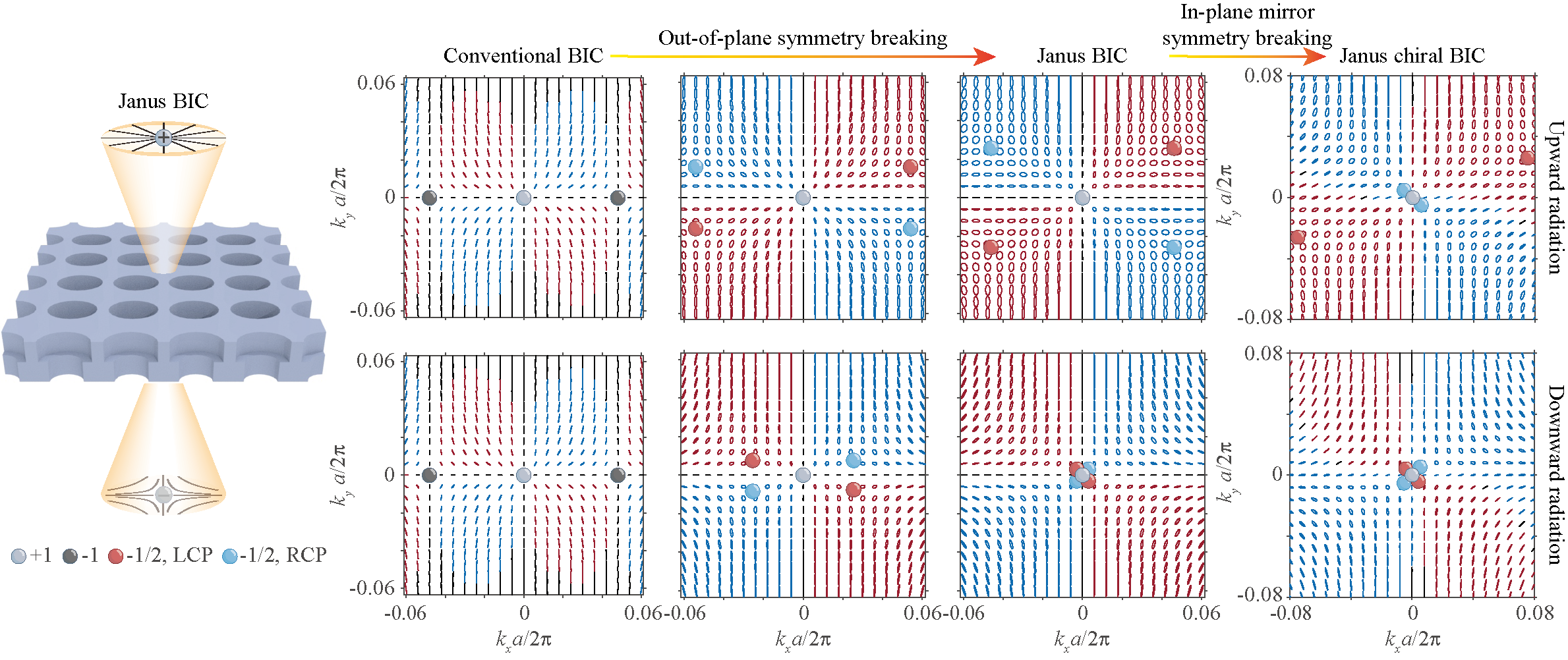
Figure 1: Schematic illustration of the concept and realization of Janus Bound States in the Continuum (Janus BICs). When the out-of-plane mirror symmetry is broken, two off-Γ point BICs split into four circularly polarized states (C-points), while the BIC at the Γ point is preserved. By selectively merging the four C-points in the downward radiation channel with the at-Γ BIC, a Janus BIC is realized. Further breaking the in-plane mirror symmetry causes two C-points with the same chirality and identical topological charge to merge into the Janus BIC, thereby achieving a chiral Janus BIC.
Link: https://doi.org/10.1103/PhysRevLett.134.013805
New18
Research progress: Topological degeneracy induced by twisting
Recently, a research team led by Professor Hui Liu from the School of Physics at Nanjing University and Professor Meng Xiao from the School of Physics at Wuhan University has proposed a novel mechanism of generating topological degeneracies by twisting between two metasurfaces. Generally, degeneracies are protected by certain symmetries of the system considered, once these symmetries are broken, degeneracies would be lifted, resulting in gapped phases. However, this work observed an opposite mechanism in a twisted bilayer photonic lattice, in which two bands are gapped in a mirror-symmetric situation, while degeneracies (band touching) emerge if the mirror symmetry is broken by a twist. Furthermore, the position of the degeneracies is mediated by the twist angle, forming a nodal chain structure in the synthetic dimension consist of twist angle and two inplane wave vectors. Above results are all examined both in theory and in experiment. The twisted lattice supports birefringent waves as the degeneracies considered as the optic axis, thus providing potential applications in integrated photonics. This work was published in the journal Physical Review Letters[Phys. Rev. Lett. 134, 106601 (2025)], entitled ‘Topological degeneracy induced by twisting’.
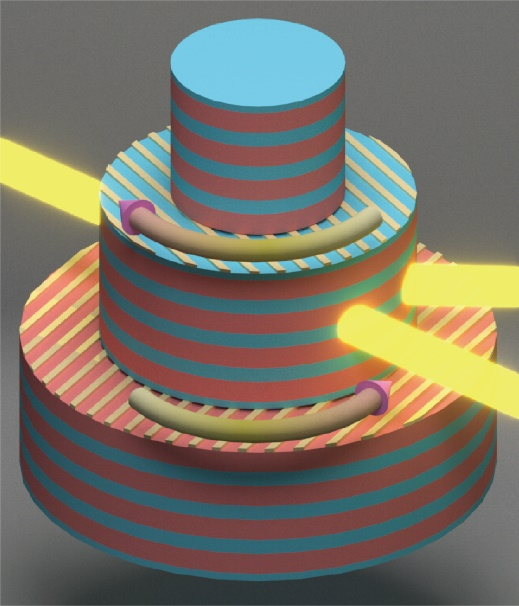
Publication link:
http://journals.aps.org/prl/abstract/10.1103/PhysRevLett.134.106601
Official Webpage (English): Nanjing University Physics Research Highlights
https://physics.nju.edu.cn/english/ResearchHighlights/20250313/i309895.html
WeChat Article (Chinese): Featured by NJU School of Physics
https://mp.weixin.qq.com/s/TSmmBlL5xqYddazaN15swQ
New17
Arbitrarily Configurable Nonlinear Topological Modes
Professor Xiao Meng's team from Wuhan University, in collaboration with Associate Professor Wan Duanduan's team, has pioneered research on nonlinear topological modes. They proposed a novel concept of arbitrarily configurable nonlinear topological modes, and related results were published in Physical Review Letters under the title “Arbitrarily Configurable Nonlinear Topological Modes”. The corresponding authors of the paper are Professor Xiao Meng and Associate Professor Wan Duanduan, with the first author being Bai Kai, a doctoral student at Wuhan University. Graduate students Jia-Zheng Li, Tian-Rui Liu, and Liang Fang also made important contributions to this work.
Topological modes are known for their robustness against disorder and defects, and they are widely used in fields such as optics, acoustics, and quantum physics. However, as inherited from the bulk-boundary correspondence, topological modes exponentially decay into the bulk and hence have limited capacity. The requirement of bulky topological materials and the limited available capacity of topological modes exhibit a bottleneck in potential applications. To overcome these challenges, we propose the concept of arbitrarily configurable nonlinear topological modes. This new type of mode not only inherits topological protection and localization features but also exhibits a unique configurability enabled by the nonlinear system, making the topological mode arbitrarily shapeable.
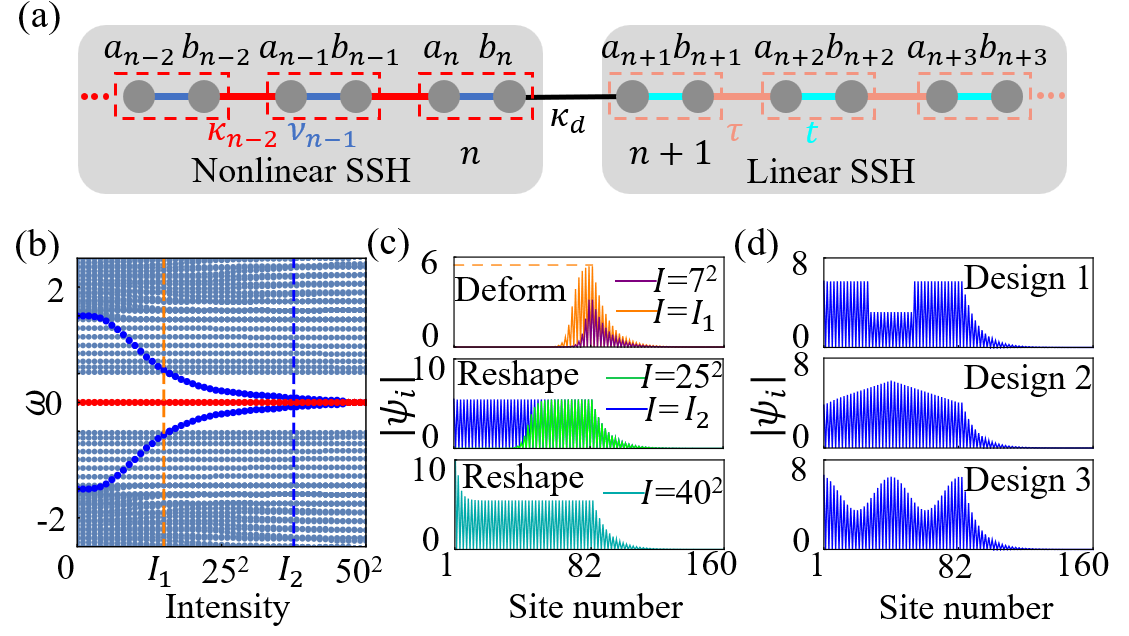
Figure 1. Arbitrarily configurable nonlinear topological modes.(a) Schematic of a tight-binding lattice.(b) Evolution of the nonlinear eigenfrequency spectrum.(c) Nonlinear topological wavefunctions under different intensities. (d) Designed topological wavefunction profiles.
This work is expected to open a new direction: "Designing topological mode profiles via nonlinear mechanisms." The proposed model demonstrates excellent topological robustness and can be extended to higher-dimensional systems. It offers a theoretical foundation and practical route for constructing a new generation of reconfigurable topological devices across a wide range of physical platforms.
Link:https://journals.aps.org/prl/abstract/10.1103/PhysRevLett.133.116602
News16
Review on applications of bound states in the continuum in photonics
Our last review titled "Applications of bound states in the continuum in photonics" has been published in Nature Reviews Physics. This review details the unique optical properties of bound states in the continuum (BICs), provides insights into the impact of BICs in various applications, and envisages their use in several emerging research frontiers.
BICs exhibit intriguing optical properties, including the ability to achieve enhanced light confinement, sharp Fano resonances, and topological characteristics. As a universal wave phenomenon, photonic systems provide a versatile platform to study and exploit BIC. The light confinement induced by BICs has the advantages of reducing the lasing threshold, improving nonlinear conversion efficiency, and enhancing waveguiding in photonic integrated circuits. Fano resonances with tailored ultra-narrow linewidth are beneficial for advanced sensing performance. Polarization vortexes emerging around BICs trigger vortex beams, optical switches, beam shifts, and polarization conversion.
We provide an outlook on the development of BICs in novel physical systems, such as parity-time symmetric systems, higher-order topological phases, exciton–photon coupling, and moiré superlattices.
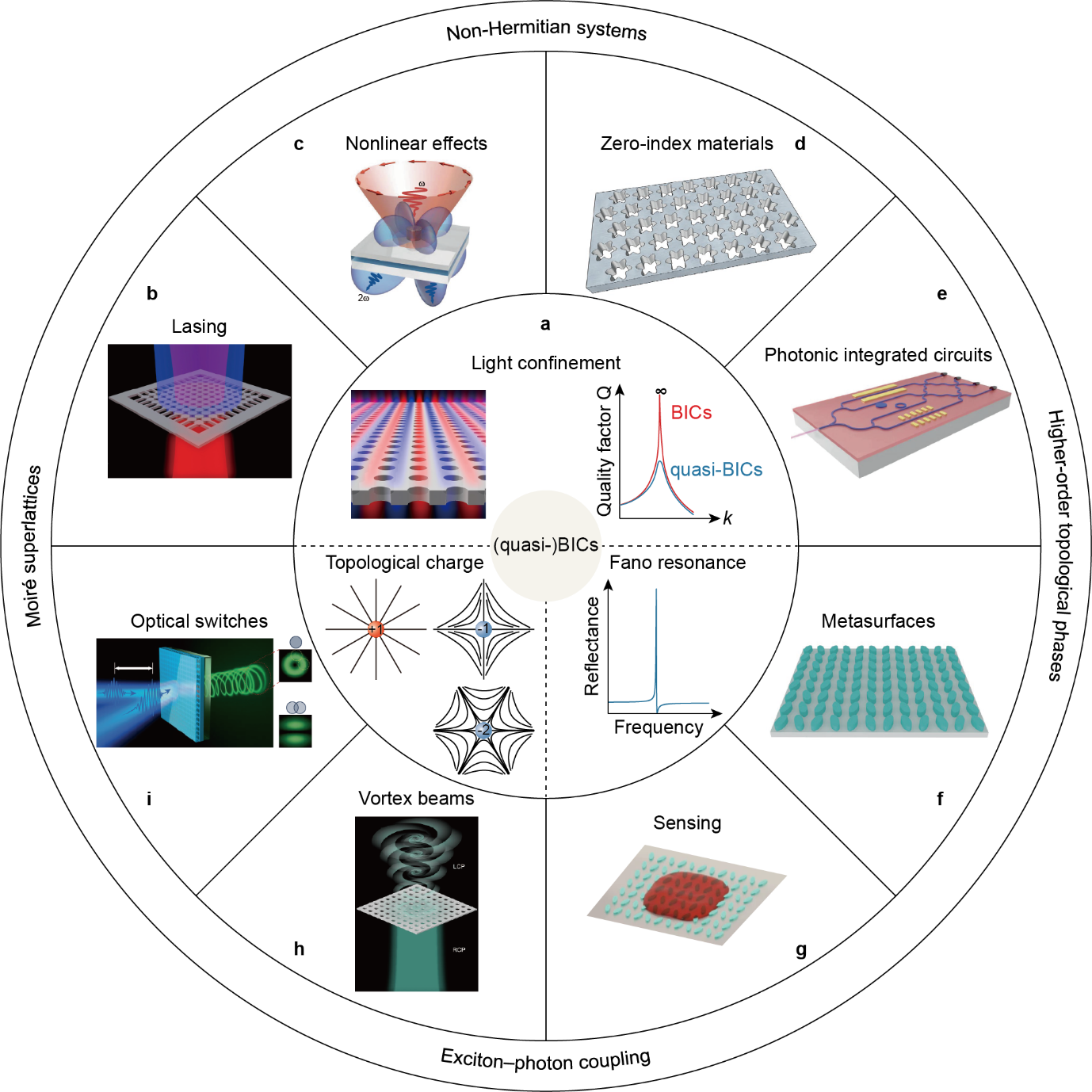
Figure 1 Overview of effects and applications of BICs.
For full text:
https://doi.org/10.1038/s42254-023-00642-8
https://rdcu.be/dnUr7
News 15
Breakthrough in Light Manipulation:
Unveiling Novel Finite Barrier Bound States
In March 2024, the journal "Light: Science & Applications" published the research results of the Meng Xiao and Duanduan Wan groups titled "Finite barrier bound state", which innovatively proposed and confirmed the existence of finite barrier bound states. At the same time, it also provides a new way to realize bound states in the continuum (BICs). The corresponding authors of the paper are Professor Meng Xiao and Associate Professor Duanduan Wan of Wuhan University, and the first author is Liu Tao, a doctoral candidate at Wuhan University.
Exploring wave propagation and localization in various media has been a core focus in optics and acoustics. Traditionally, it was believed that boundary modes in photonic crystals are strongly influenced by the size of the crystal (number of lattice sites). It was generally assumed that these modes are more easily confined in large systems (with many lattice sites) as the probability of tunneling decreases significantly with increasing system size. Additionally, in photonic crystal research, bound states in the continuum (BICs) have attracted attention as they reveal that certain unique modes can be confined within specific regions even in the continuous spectrum.
Research Innovation
This research innovatively proposes and confirms the existence of finite barrier bound states. The spectrum of a system typically consists of continuous and discrete spectra (left panel of Fig. 1). Conventional wisdom holds that the eigenvalue spectrum of bound states is discrete, while unbound states form a continuous spectrum. These discrete states can be localized entirely in ideal conditions (infinite barrier width, Fig. 1-II). However, when the barrier width is finite, there's a probability for the state to tunnel through the barrier and become a resonant state (Fig. 1-III). Notably, bound states in the continuum (BICs) are spatially bound within the continuous spectrum's energy/frequency range (Fig. 1-I). This study introduces a counterintuitive concept parallel to BICs: certain states can be bound entirely in very thin bandgap materials, making them unable to tunnel through the bandgap material(Fig. 1-IV and 1-V).

Fig. 1 | Illustration of bound state in the continuum (BIC), regular bound state, resonance state and finite barrier bound state. Counterintuitively, as insets IV and V show, a state gets trapped completely by a band gap material with a finite and very small thickness.
The study first demonstrates a special mirror-symmetric photonic crystal strip structure where the transition of boundary modes can be finely controlled. When the width of the photonic crystal (the number of lattice sites along the y-direction, Ny) is small, the boundary modes on both sides interact and split into odd and even modes. (Fig. 2a-d) At specific wave vectors (nodes), the coupling strength of the boundary modes is zero. Even if the width (Ny) of the photonic crystal is very small, the boundary mode cannot jump from one side of the photonic crystal to the other. (Fig. 2e-f) Generally, it is believed that many lattice sites are required to suppress the coupling of boundary modes. Still, this study challenges this view and opens a new method for manipulating photon behavior at the microscopic scale.

Fig. 2 | The first configuration, a strip geometry of a photonic crystal (PC) truncated by PECs on both sides. a, Illustration of the experimental setup for the case of Ny=3. b, The band structure for Ny=3 (The gray region is projected band structure). c-d, Measured (color code) and simulated (lines) band structures for Ny= 2 and 3, respectively. e-f, Simulated and experimental electric field distributions for Ny= 4 at a non-node frequency and a node frequency.
Following the previous configuration, researchers remove one PEC boundary of the photonic crystal, revealing a new configuration. They discovered that the remaining boundary modes at specific nodal wave vectors are entirely trapped, forming Finite Barrier Enabled Bound States in the Continuum (FBICs). These FBICs exhibit non-radiating properties due to the decoupling of the two boundary modes. Additionally, by altering the circular dielectric to elliptical to break the original mirror symmetry and introducing a new geometric parameter η, the study defined a winding number in the kx-η parameter space, revealing the topological characteristics of FBICs and confirming these modes as BICs. (Fig. 3a-b) Considering the unavoidable dielectric loss at microwave frequencies, the study experimentally validated FBICs by measuring the attenuation of boundary modes (Fig. 3c-d), demonstrating complete localization of boundary modes within very few lattice sites (Ny=2, 3, etc.), offering a novel approach to achieve BICs.
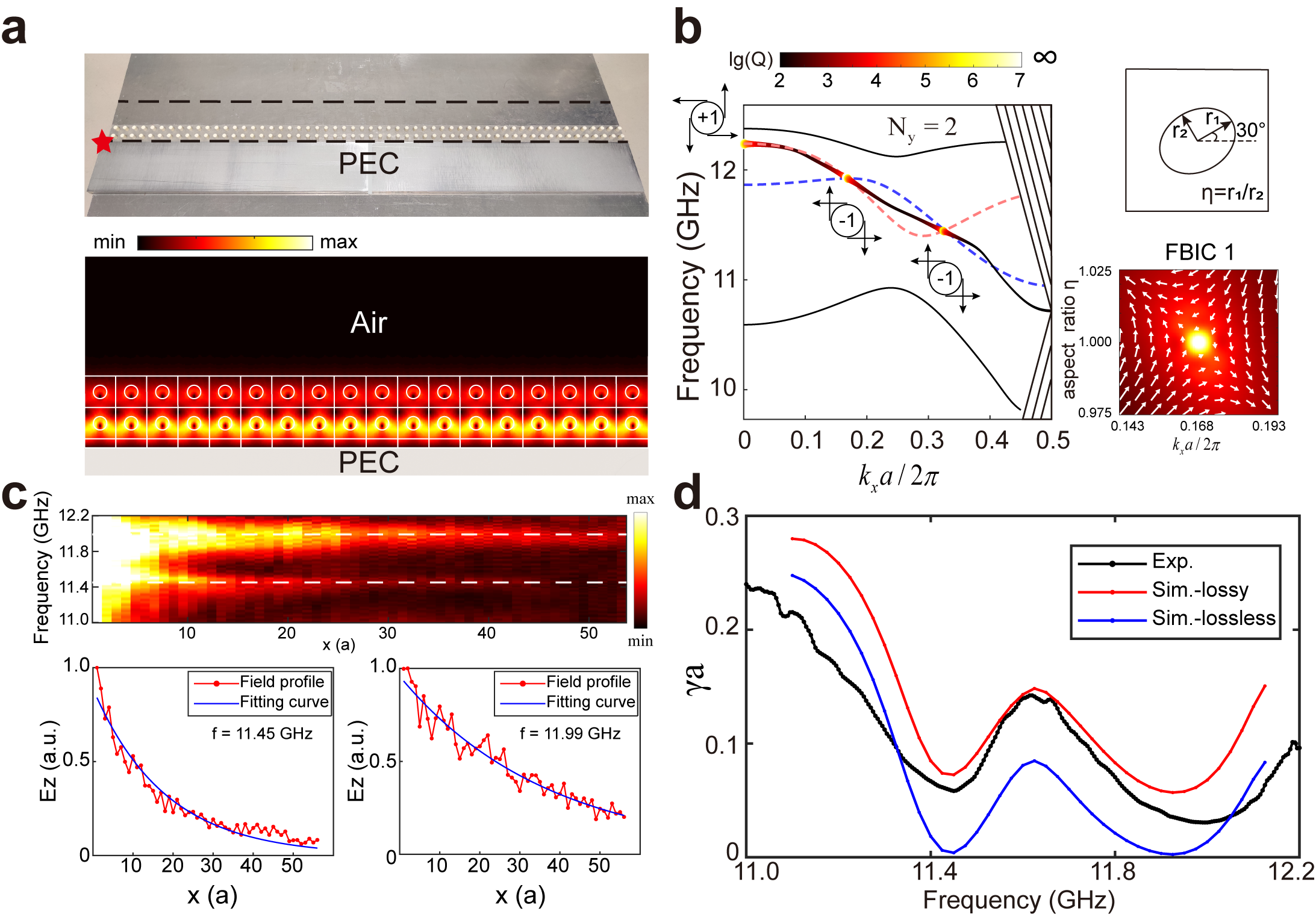
Fig. 3 | The second configuration, one of the PEC boundaries is replaced by air. a, The photo of the sample with Ny= 2 and the eigenfield amplitude distribution at the nodal wave vector. b, The band structure for Ny= 2, the corresponding Q factor of boundary mode, the definition of geometric parameter η and the topological characters of the FBIC. c-d, The field distribution and attenuation characteristics of boundary modes in the second configuration.
This groundbreaking study explores novel physical phenomena in photonic crystals and achieves fine control of boundary modes. This work not only provides a new understanding of the tunneling and bounding of boundary modes in photonic crystals theoretically but also confirms the complete localization of boundary modes at specific wave vectors through microwave experiments, bringing a new perspective to the field of photonics. The research reveals new methods for manipulating photon behavior, which is significant for developing highly integrated photonic devices. It also offers new strategies for using photonic crystals to enhance light-matter interactions, potentially leading to breakthroughs in nonlinear optics and interactions between light and two-dimensional materials. These findings may inspire future research, such as applying these principles to other wave systems like phononic crystals.
Related news links: https://mp.weixin.qq.com/s/ya7BcpFr65W9TVrvqJKhyA
Full text link: Finite barrier bound state | Light: Science & Applications (nature.com)
News 14
Nonlinear Exceptional Points with a Complete Basis
in Dynamics
Professor Xiao Meng's team from Wuhan University, in collaboration with Associate Professor Wan Duanduan's team, has pioneered research on the effects of nonlinear gain on non-Hermitian exceptional points. They have proposed and experimentally verified the existence of exceptional points with a complete basis in the dynamical process. The related research results were published under the titles "Nonlinear Exceptional Points with a Complete Basis in Dynamics" and "Observation of Exceptional Nonlinear Points with a Complete Basis in Dynamics" in the journal Physical Review Letters. The corresponding authors of the paper are Professor Xiao Meng and Associate Professor Wan Duanduan, with the first author being Bai Kai, a doctoral student at Wuhan University. Additionally, Wuhan University doctoral student Fang Liang, Liu Tian-rui, master's student Li Jia-zheng, and undergraduate student Lin Chen also made outstanding contributions to this subject.
An exceptional point (EP) is a type of special spectral singularity where two or more eigenmodes coalesce, causing their eigenvectors to become identical, and as a result, the completeness of the Hamiltonian's eigenbasis is lost. The unique physical properties near EPs have led to various novel applications, such as signal amplification, laser mode resolution, detection of minute signals, quantum sensing, energy transfer, photonic chips, unidirectional lasers, quantum control, mode conversion, and more. However, as the parameters approach an EP, the system noise significantly increases due to the eigenvectors becoming identical, which can greatly hinder the realization of the aforementioned applications. To address this, we introduce the concept of a nonlinear exceptional point (NEP). While maintaining the fundamental characteristics of a linear EP, it restores the completeness of the effective Hamiltonian's eigenbasis in the dynamical process, fundamentally solving the noise divergence issue caused by the aggregation of eigenbasis vectors.
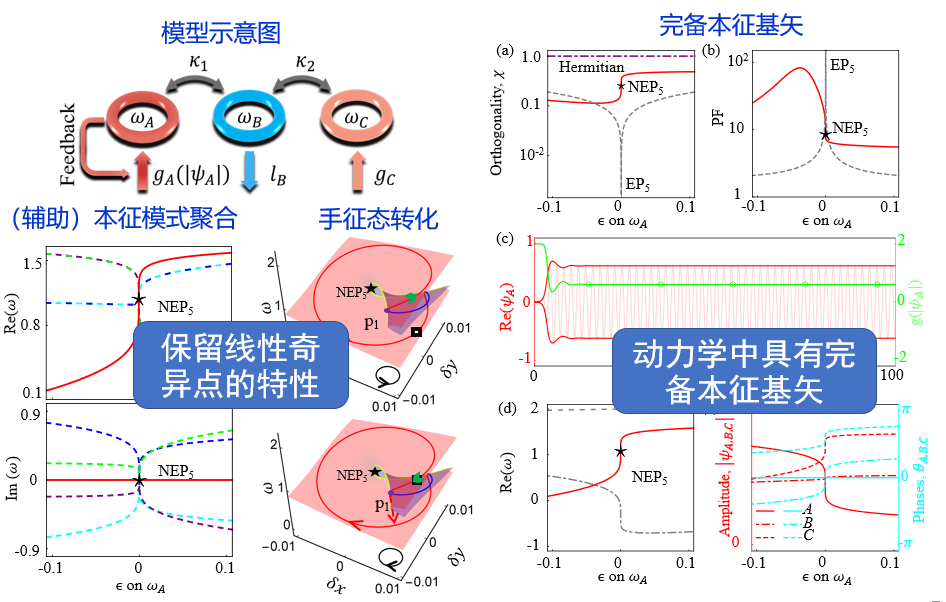
Left panel shows the key features of EPs, the right panel shows the complete basis in dynamics.
Subsequently, we designed the minimal model for observing NEP, and observed a NEP3 based on circuit experiments.
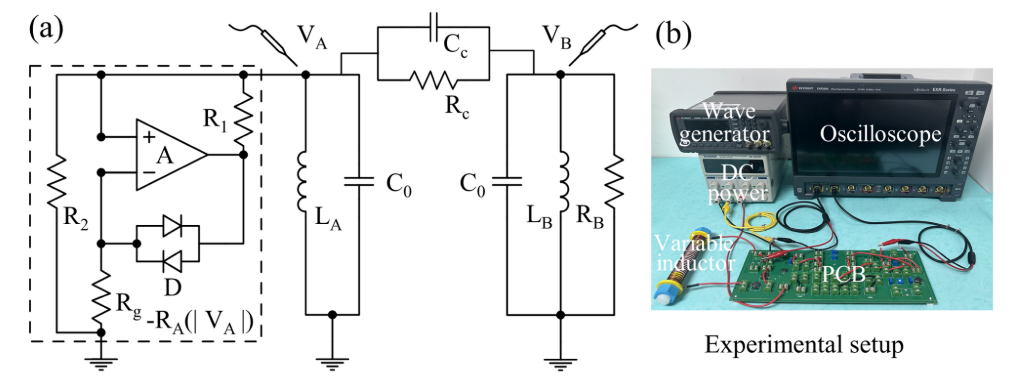
(a) The circuit used in the experiment (b) A photo of the experimental setup.
Link:https://link.aps.org/doi/10.1103/PhysRevLett.132.073802
Link:https://link.aps.org/doi/10.1103/PhysRevLett.130.266901
News 13
Nonlinearity enabled higher-order exceptional singularities with ultra-enhanced signal-to-noise ratio
Our new paper titled “Nonlinearity enabled higher-order exceptional singularities with ultra-enhanced signal-to-noise ratio” is published in National Science Review. This work provides a simple while intuitive example by demonstrating with both theory and circuit experiments an “exceptional nexus” (“EX”), a higher-order exceptional point (HOEP). This HOEP is realized within only two coupled resonators with the aid of nonlinear gain. Moreover, such a HOEP exhibits an ultra-enhanced signal-to-noise ratio.
The recent advances in non-Hermitian physics, such as sensitivity enhancement, skin effects, and mode braiding, are underlain by the exceptional points (EPs). Over the last few years, there has been an ongoing debate about whether EPs can improve the sensor's performance or not. Possible arguments include stringent parameter requirements, fundamental resolution limits, and noise amplification near the EPs. Facing these challenges, researchers intend to conclude that EPs, even higher-order EPs (HOEPs), enhance responsivity instead of signal-to-noise ratio. Here, our result shows that such a nonlinearity enabled HOEP exhibits not only diverging responsivity but also diverging signal-to-noise ratio. Exploring the nonlinear gain saturation in non-Hermitian systems, our work demonstrates with both theory and circuit experiments an exceptional nexus (EX), a HOEP, within only two coupled resonators. Intriguingly, the above-mentioned difficulties encountered for other EPs in sensing can be naturally reconciliated due to the exquisite dimension correlation in this nonlinear system. Moreover, the signal-to-noise ratio is significantly improved in the proximity of HOEP.
This result can have significant instant impacts on the fundamental understanding of the exceptional singularities of nonlinear non-Hermitian systems, and may open new avenues for applications such as ultrasensitive measurements.
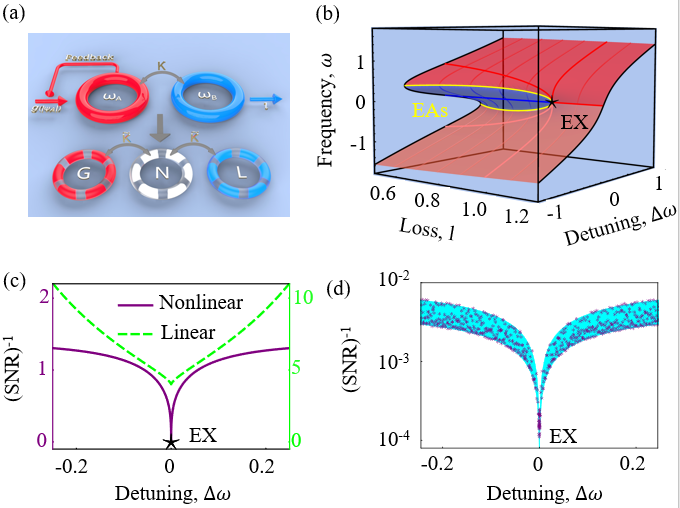
(a)The upper panel shows a nonlinear two-coupled-resonators system. The lower panel shows a linear three-coupled-resonators system. (b) Steady-state solution of nonlinear Schrödinger equation. (c) (SNR)-1 from the analysis of stable states. (d) (SNR)-1 from the system dynamics。
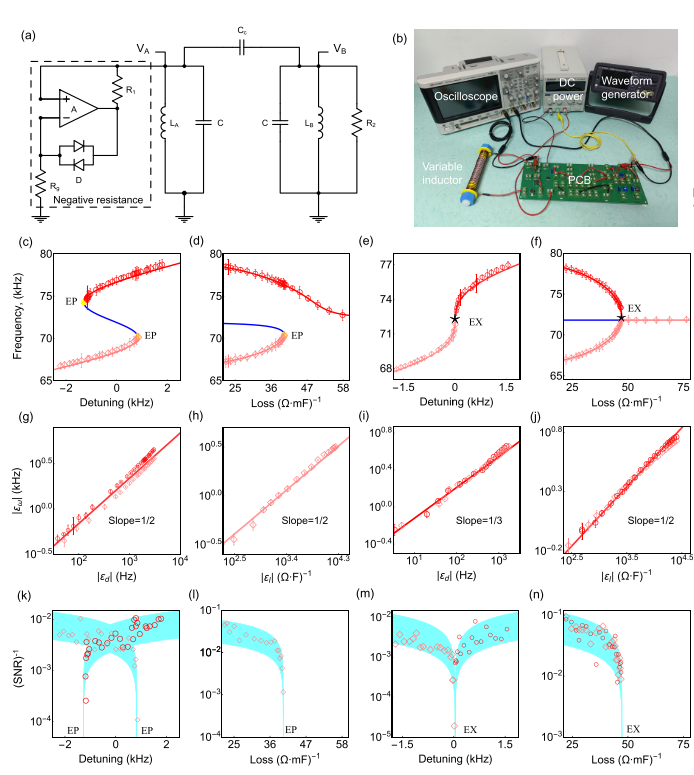
(a) Circuit used for experimental verification. (b) Photo of the experimental setup. (c-f) Measured resonance frequencies. (g-j) show the critical behavior near the corresponding EPs and EX in (c-f), respectively. (k-n) show the corresponding (SNR)-1.
For full text:https://doi.org/10.1093/nsr/nwac259
News 12
Space-Time Wave Packet in Dispersive Media
Our new paper titled “Nondispersive Space-Time Wave Packet Propagating in Dispersive Media” is published in Laser & Photonics Reviews.
In this work, we propose a new scheme to overcome chromatic dispersion in any dispersive medium at arbitrary wavelengths without using additional compensating elements. Specifically, we introduce a new type of propagation-invariant space-time wave packets that exhibit neither diffraction nor dispersion in a dispersive medium. Such wave packets have a special form of spatio-temporal spectral correlation that precisely compensates the chromatic dispersion under propagation. We also discover a modified law of refraction for such non-dispersive space-time wave packets.
Our work highlights the significant opportunities of spatio-temporal engineering in dispersion compensation and may enable potential applications of space-time wave packets. Our work also points to the significant opportunities for creating space-time wavepackets in other general wave systems with different dispersion relations, such as acoustic waves or quantum waves.
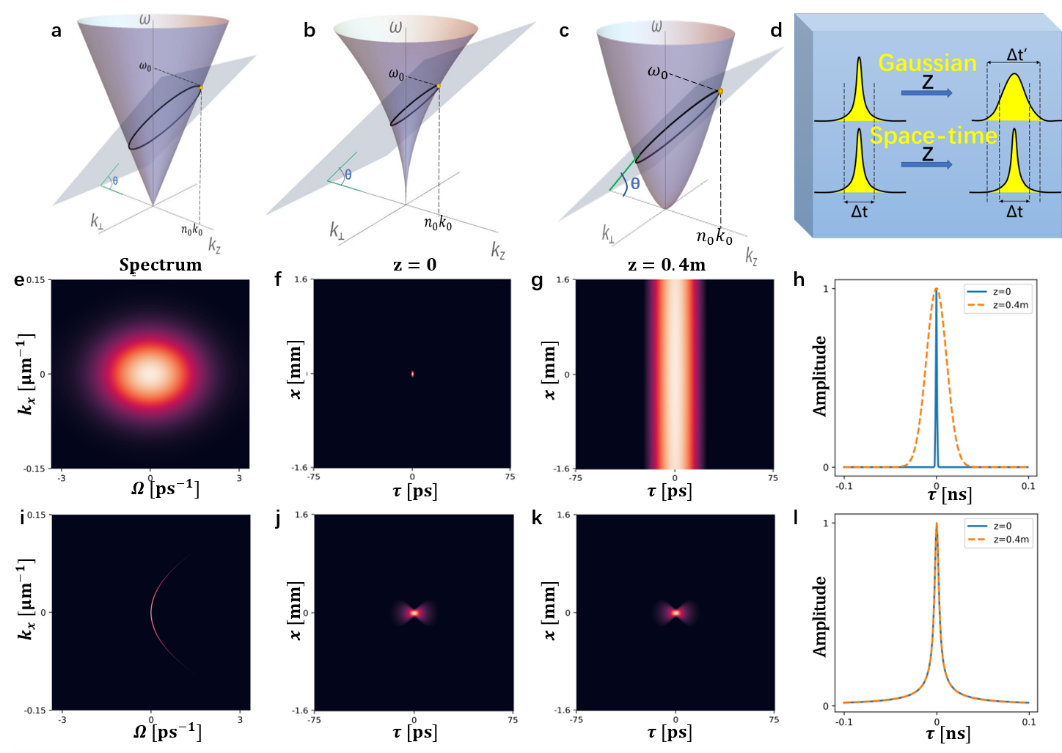
Fig 1:a-c Light cone of free space (a) and dispersive medium (b, c). d Gaussian wave packet spreads in dispersive medium while the space-time wave packet remains invariant. e-h Spectrum and intensity distribution of Gaussian wave packet. i-l Spectrum and intensity distribution of space-time wave packet.

Fig 2:Modified law of refraction for space-time wave packet.
Related news:https://mp.weixin.qq.com/s/0XB-QfqIyeL-piDDwNgGnQ
For full text: https://onlinelibrary.wiley.com/doi/10.1002/lpor.202100634
News 11
Improving the Robustness of Bound States in the Continuum by Harnessing Higher-order Topological Charges
Bound states in the continuum (BICs) have attracted broad research interests owing to their excellent performance in light confinement, which can boost light-matter interaction. BICs can eliminate the radiation loss to achieve an infinity quality factor Q theoretically. However, in practical on-chip resonators, there are inevitable fabrication imperfections that would couple BIC to nearby radiative states by scattering, thus limiting the available Q. To suppress the scattering loss, the improvement of light confinement in the nearby radiative states is required. Multiple BICs can be tuned to the same position to form a merging BIC using the topological properties of BIC. This physical mechanism can significantly enhance the Q of nearby states over a broad wavevector range and improve the robustness of BICs against the scattering loss of fabrication imperfections.
For photonic crystal slabs, the polarizations of the far-field radiation form a polarization vortex around a BIC in momentum space. The BIC is located at the topological singularity, whose polarization direction cannot be defined, so there is no radiation loss. The winding number of polarizations along the counterclockwise direction defines the topological charge of BICs. BICs are topologically protected following the topological charge conservation. They are tunable in momentum space with the variation of structural parameters.
However, to date, the construction of merging BICs involves only the manipulation of fundamental topological charges.
In a new paper published in Light Science & Applications, Prof. Meng Xiao from Wuhan University, Prof. Hongxing Xu’s team from Wuhan University, and Prof. Che Ting Chan from the Hong Kong University of Science and Technology cooperated to propose a novel physical mechanism for realizing merging BICs through manipulating higher-order topological charges.
In the photonic crystal slab with a triangular lattice, there is a symmetry-protected BIC with a topological charge of -2 at the G points. When the thickness of the slab is appropriate, accidental BICs with topological charges of ±1 appear at off-G points, which are formed by the accidental cancellation of radiation loss because of destructive interference. By varying the thickness, multiple accidental BICs can be simultaneously tuned to the G points, forming a merging BIC with a higher-order charged BIC. The Q factors of the nearby radiative states have been significantly enhanced for nearby radiative states compared with isolated BICs or merging BICs with only fundamental charges. In short summary, merging BICs involving higher-order charges can further improve the light confinement and suppress the scattering loss caused by fabrication imperfections.
By replacing cylindrical holes with elliptical cylindrical holes, the symmetry of the structure is reduced and higher-order charged BICs are no longer allowed at the G point. Because of topological charge conservation, BICs with the higher-order topological charge split into off-G BICs. The split BICs can be tuned in momentum space by varying the structural parameters. They can be simultaneously tuned to the G point to form a merging BIC, or to the same position with accidental BICs and form a merging BIC at off-G points.
By rotating elliptical cylindrical holes, the mirror symmetry is further broken and BICs are turned away from the mirror plane. By choosing a suitable rotation angle and slab thickness, the merging BIC are steerable with a designed momentum, which is of great significance for improving the performance of direction-rrelated applications.

Figure| Merging BICs by harnessing higher-order topological charges.
Related news:https://mp.weixin.qq.com/s/VPlZa_aMPZj4uqPdrAAgtg
For full text:https://www.nature.com/articles/s41377-022-00923-4
News 10
Acoustic Topological Dislocation Modes
Our new paper titled “Topological dislocation modes in three-dimensional acoustic topological insulators” is published in Nature Communications.
In this work, we experimentally construct a three-dimensional (3D) acoustic topological insulator with precisely-controlled dislocations and present an unambiguous evidence for the long-sought bulk-dislocation correspondence. The delicate design of our acoustic system enables us to observe not only the topological dislocation modes (TDMs) in momentum-resolved frequency spectroscopy but also their spatial localization in pressure-field distributions. The topological robustness of the TDMs is identified by introducing a spin-preserved defect to the dislocation. Significantly, the TDMs observed here exhibit flexibilities in wave manipulations since the dislocation lines can be deformed at will in 3D space. As such, we can design dislocation waveguides of arbitrary shapes and unidirectionally guide the TDMs along any prescribed routes inside the bulk materials, which are conclusively identified by our acoustic experiments.
Our findings will stimulate the study on the highly-intriguing interaction between the real-space topology and band topology. The peculiar topological dislocation transport points to new possibilities for information communication and energy transportation.
Fig. 1. TDMs guided by the dislocations in a 3D topological insulator.
Fig. 2. Numerical demonstrations of the acoustic TDMs and their topological transports.
Fig. 3. Experimental characterizations of the acoustic TDMs and their topological robustness to defects.
For full text:
https://www.nature.com/articles/s41467-022-28182-2
January 2022
News 9
Photonic Dirac Nodal Line Semimetal
Our new paper titled “Double-bowl State in photonic Dirac nodal line semimetal” is published in Light: Science & Applications.
In this work we investigate a photonic Dirac nodal line semimetal (DNLS), which is not a trivial spinless extension of the electronic DNLS, and thus indicates the possibility of identifying new mechanisms unique for photonics to protect topological phases. We provide a stringent photonic realization of type-II DNLS with a ring shape four-fold band degeneracy. We measure the dispersion of the DNLS along relevant directions and thus provide the smoking gun for the realization of photonic DNLS. We deposit a silver film on top of this photonic DNLS and identify the double-bowl surface states possessed by this composite system through angle-resolved spectra.
Our system can serve as an ideal platform for investigating phenomena that require large field enhancement as well as manipulating light with an arbitrary polarization while studying polarization-sensitive light-matter interactions.
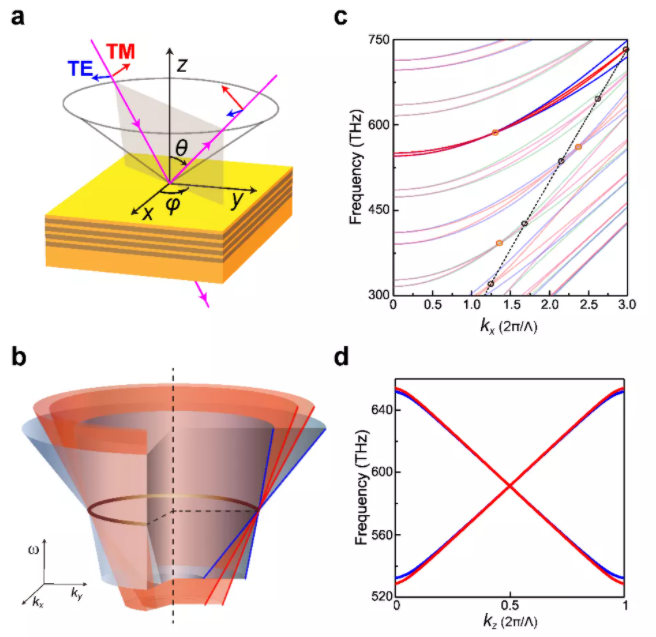
Fig. 1. Photonic Dirac nodal line semimetal.

Fig. 2. Experimental observation of photonic Dirac nodal ring.
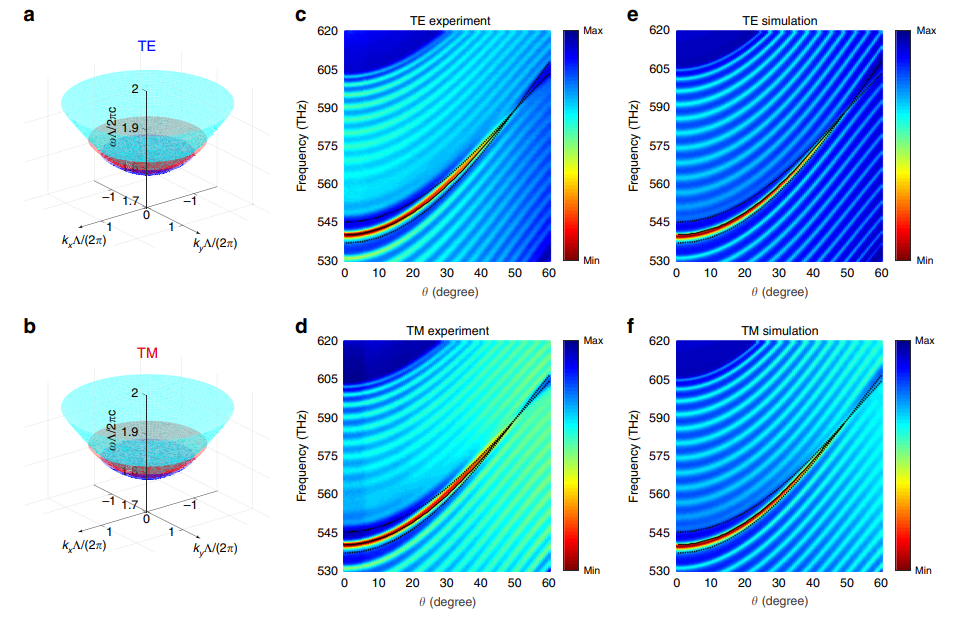
Fig. 3. Observation of the double-bowl states.
For full text:
https://doi.org/10.1038/s41377-021-00614-6
August 2021
News 8
Second Harmonic Enhanced with Photonic Weyl “Fermi Arcs” on LNOI Chips
Our new paper titled “Probing rotated Weyl physics on nonlinear lithium niobate-on-insulator chips” is published in Physical Review Letters.
In this work, we report the first topological device on a lithium niobate-on-insulator (LNOI) chip. We design a 1D quaternary waveguide lattice on a LNOI chip. Based on this system, we obtain Weyl points and the Fermi arc edge states induced by them with the aid of a synthetic parameter space. We also explore the intriguing rotated Weyl physics in a 3D synthetic space. We find whether the interface between two Weyl structures can host gapless topological interface states or not, is determined by the relative rotational angle of the two Weyl structures. If the two Weyl structures rotate in the same (opposite) direction, topological interface states presence (absence). We also observed experimentally the second-order nonlinear enhancement of the topological interface state due to the second-order nonlinearity of the lithium niobate material.
Our work shows that LNOI provides a flexible platform for many other topological devices. It also opens up a new paradigm for experimentally exploring various applications in integrated nonlinear and quantum optics.
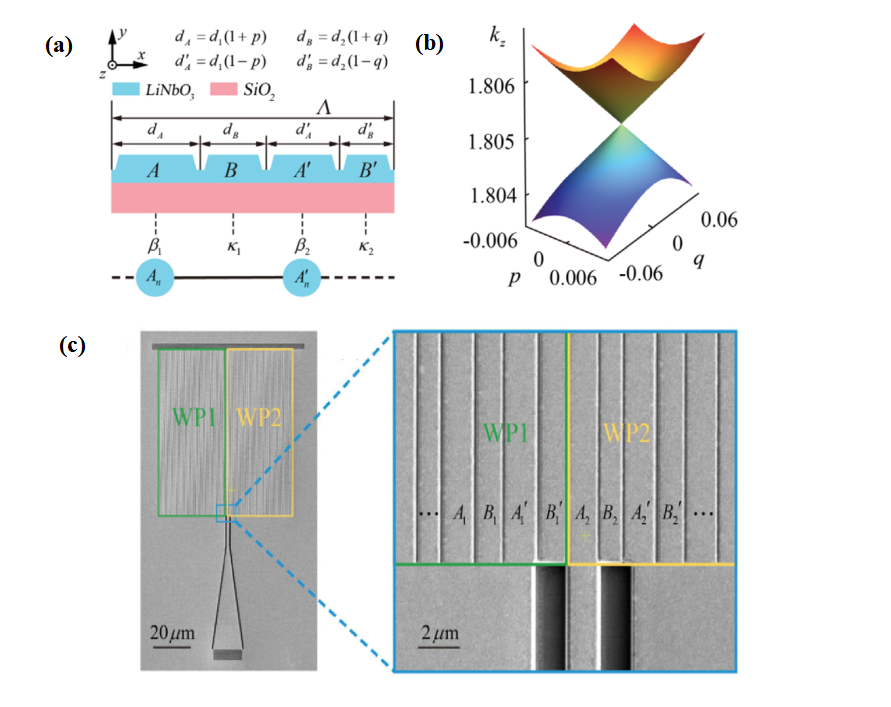
Fig. 1.(a) Cross section diagram of a unit cell that consists four waveguides which simulates the Weyl physics in (b). (c)Domain wall between two Weyl systems formed with waveguides on LNOI chips.
For full text:
https://journals.aps.org/prl/abstract/10.1103/PhysRevLett.127.013901
July 2021
News 7
Topological Rainbow Energy Concentrator
We propose a method to realize topological rainbow concentrator based on synthetic dimension. This work is published in Physical Review Letters.
Synthetic dimension provides a new platform for realizing topological photonic devices. We realize a topological rainbow concentrator by constructing a synthetic dimension. The synthetic dimension is constructed using a translational degree of freedom of the nanostructures inside the unit cell of a two-dimensional photonic crystal. The translational deformation induces a nontrivial topology in the synthetic dimension, which gives rise to robust interface states at different frequencies. The topological rainbow can trap states with different frequencies, controlled by tuning the spatial modulation of interface state group velocities. The operation frequency as well as the bandwidth of the topological rainbow can be easily tuned by controlling the band gap of the photonic crystal.
Our work provides a universal method for the realization of topological rainbow concentrators based on the notion of synthetic dimension, and it will enable practical applications such as topological routers and optical information processing.
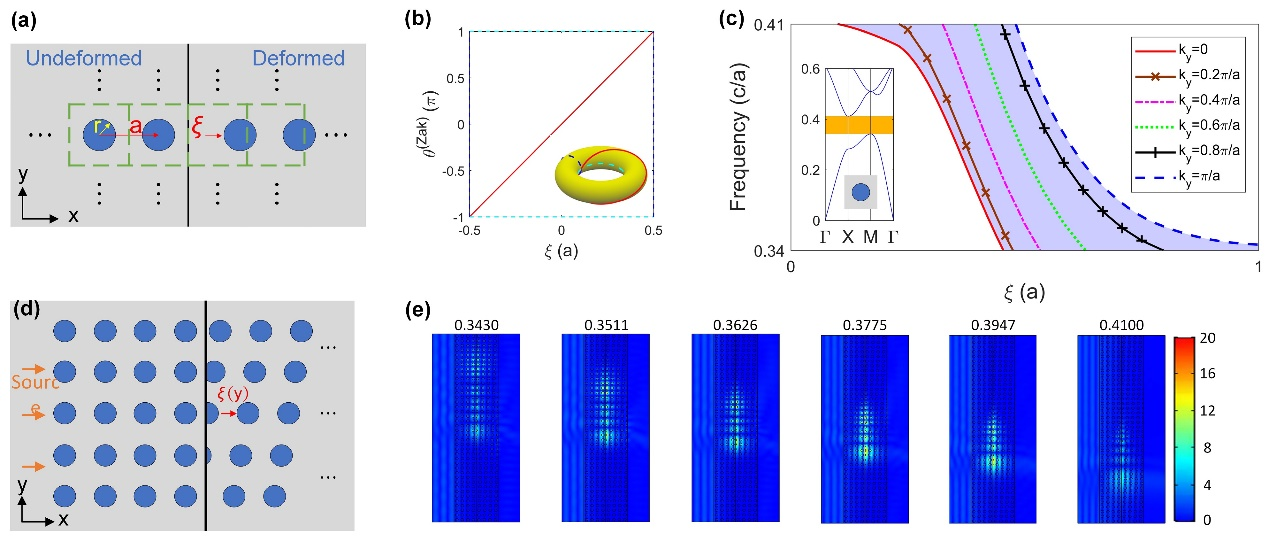
Fig. 1. Topological rainbow concentrator constructed in the synthetic dimension.
For full text:
https://journals.aps.org/prl/abstract/10.1103/PhysRevLett.126.113902
March 2021
News 6
Free Merging BICs
Our new research on merging bound states in the continuum (BICs) has been published in Physical Review Letters.
BICs are localized resonances embedded in the continuum spectrum by eliminating radiation loss. They have unique advantages in trapping light. Merging BICs can suppress the scattering loss induced by the fabrication imperfections but they are only limited to Γ point before our work.
In this work, we propose a new scheme to construct merging BICs at almost an arbitrary point in the reciprocal space. Instead of merging only accidental BICs at Γ point in the previous work, we show the concurrence of an accidental BIC and a Friedrich-Wintgen BIC (FW-BIC) and then tune them to merge at an off-Γ point. We design a PCS made of Si3N4 and immersed in a liquid (common in lab) to demonstrate our idea and such a proposal can be readily verified experimentally. By breaking the in-plane mirror symmetry, the merging BIC can be tuned to almost an arbitrary position in the reciprocal space. Since FW-BICs and accidental BICs are quite common on the band structure, our proposal provides a general approach to realize off-Γ merging BICs.
Our work enriches the explorations of topological photonics and can boost applications desiring strong light-matter interactions, including nonlinear effects, sensors, lasing and optoelectronic devices.

Fig. 1. Merging the FW BIC and accidental BIC with opposite topological charge
For full text:
https://journals.aps.org/prl/abstract/10.1103/PhysRevLett.126.117402
March 2021
News 5
Nature Collection for the 40th Anniversary of the Quantum Hall Effect
The discovery of quantum Hall effect in 1980 has inspired new theories and led to experimental discoveries in a range of fields. To celebrate the diverse legacy of this discovery, Nature selects its related review, news and commentary articles and makes a collection. Two review articles from our group have been included in this collection. One is published in Nature Communications Physics in 2018, entitled “Topological sound”. The other is published in Nature Reviews Physics in 2019, entitled “Topological phases in acoustic and mechanical systems”.

Link to this Nature collection:
https://www.nature.com/collections/fdbjbijfea
For the two works mentioned above:
https://www.nature.com/articles/s42254-019-0030-x
https://www.nature.com/articles/s42005-018-0094-4
July 2020
News 4
Higher Order Topological Insulator: Acoustic Quadrupole Topological Insulator
Our recent experimental work about acoustic quadrupole topological insulators is published in Physical Review Letters.
Recently, tremendous efforts have been devoted to realizing high-order topological insulators (HOTIs). Quadrupole topological insulators (QTIs), featured with nontrivial bulk quadrupole moments, are proposed as the first type of HOTIs. However, the tight-binding model proposed for such emergent topological insulators demands both positive and negative hopping coefficients, which poses a great challenge in practical realizations.
In this Letter, we introduce a simple mechanism to construct positive and negative hoppings in acoustics. We present the first experimental realization of the acoustic QTI that stringently fulfills the tight-binding model proposed for QTI theory. The hierarchy topology of our acoustic QTI has been conclusively identified through detecting the acoustic responses at the bulk, edge and corner. The arbitrary controlling of the real-valued hoppings enables the further investigation of rich physics inherent in Z2-gauge transformation. Our study can also be extended to other HOTIs such as three-dimensional octupole topological insulators and semimetals, and open new application avenues for the robust and highly confined topological in-gap states.

Fig. 1. Acoustic realizations of negative and positive hoppings.

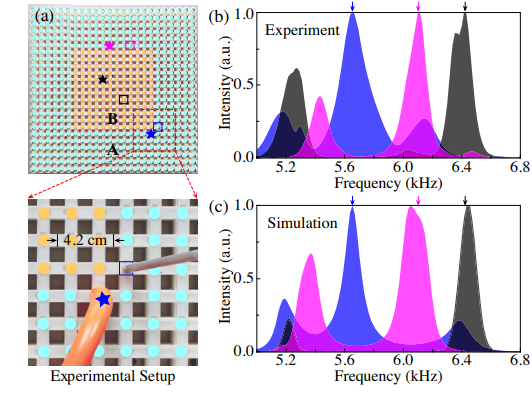
Fig. 2. Realizations of acoustic quadrupole topological insulators and experimental demonstration.
For full text:
https://link.aps.org/doi/10.1103/PhysRevLett.124.206601
May 2020
News 3
Topologically Charged Nodal Surface Identified with Acoustic Metacrystal
Our new research on semimetal with topologically charged nodal surface is published in Science Advances, entitled “Experimental demonstration of acoustic semimetal with topologically charged nodal surface”.
This paper proposes, for the first time, the concept of topologically charged nodal surface, and shows that such an object can be implemented in a tight-binding model as well as a suitably designed 3D phononic crystal that works for acoustic waves. Furthermore, we have experimentally measured the acoustic analogue of “Femi-arcs” for the topologically-protected surface states, which serves as an evidence for the nonzero charge possessed by the nodal surface. Strikingly different from those well-known Weyl semimetals where the surface state arcs are pinned to the Weyl points, here the end of the arcs depend sensitively on the surface truncation of the acoustic semimetal.
Our work indicates that topologically charged objects in a band structure is not restricted to 0D, and points to abundant unexplored features of the novel phenomena associated with the topological charges such as chiral anomaly and negative magnetoresistance in condensed matter systems.
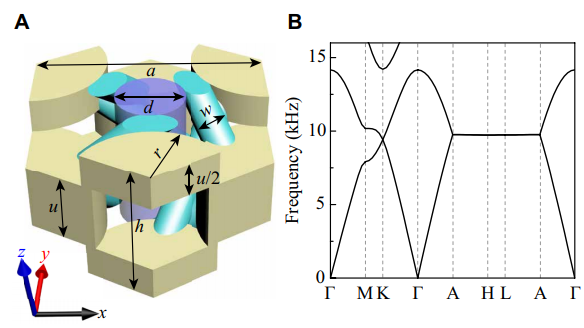
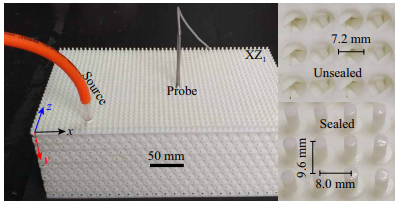
Fig. 1. A 3D phononic crystal designed with a charged nodal surface.
For full text:
https://advances.sciencemag.org/content/6/8/eaav2360.abstract
May 2020
News 2
Meron Spin Textures Found in Momentum Space
We reveal the intrinsic meron pseudospin texture in momentum space in a photonic crystal slab, which can be directly observed as meron and antimeron spin texture by polarimetric study of high-order diffracted light from the system. This work is published in Physics Review Letters.
Spin textures, the spin configurations in either real space or momentum space, are of great interest in various fields of physics and are relevant to many nontrivial physical phenomena. Skyrmions, merons and antimerons are non-singular topological spin textures that have been extensively studied in various systems. Photons are massless spin-1 particles, thus skyrmion-related objects can emerge as transverse spin textures, i.e., polarization of photons as well.
In this work, we report meron and antimeron in momentum space using a honeycomb photonic crystal slab. The existence of such objects has not been previously noted either in electronic or photonic systems. Breaking the inversion symmetry of a honeycomb photonic crystal gaps out the Dirac cones at the corners of Brillouin zone. The spin textures of photonic bands near the gaps exhibit a meron or antimeron. Unlike the electronic systems, the spin texture of the photonic modes manifests directly in the polarization of the leakage radiation, as the Dirac points can be above the light line.
Our work highlights the significant opportunities of using photonic structures for the exploration of topological spin textures, with potential applications towards topologically robust ways to manipulate polarizations and other modal characteristics of light.
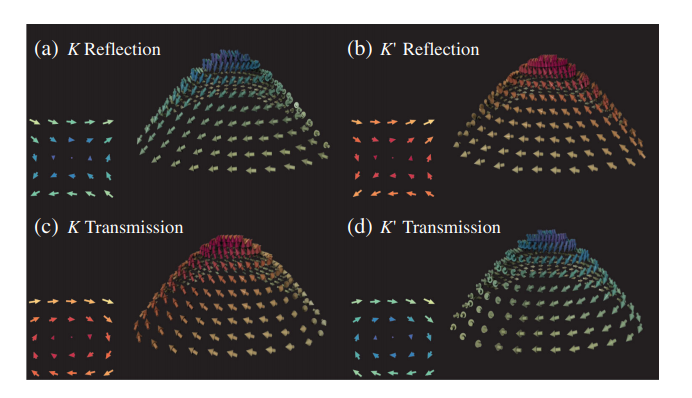
Fig. 1. The spin textures of the leakage radiation on the iso-frequency contours of the photonic band structure.
For full text:
https://journals.aps.org/prl/abstract/10.1103/PhysRevLett.124.106103
May 2020
News 1
Our latest review article is published in Nature Reviews Physics, entitled “Topological phases in acoustic and mechanical systems”.
The study of classical wave physics has been reinvigorated by incorporating the concept of the geometric phase, which has its roots in optics, and topological notions that were previously explored in condensed matter physics. Recently, sound waves and a variety of mechanical systems have emerged as excellent platforms that exemplify the universality and diversity of topological phases.
In this Review, we introduce the essential physical concepts that underpin various classes of topological phenomena realized in acoustic and mechanical systems: Dirac points, the quantum Hall, quantum spin Hall and valley Hall effects, Floquet topological phases, 3D gapless states, Weyl crystals and etc.
For full text:
https://www.nature.com/articles/s42254-019-0030-x
March 2019
